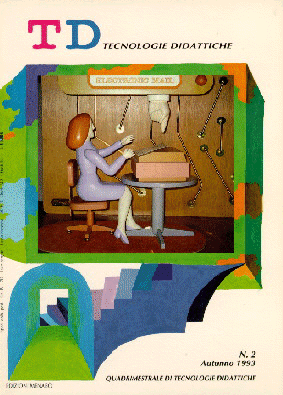Telematics in education: when and how
Main Article Content
Abstract
Article Details
Section
Authors who publish with this journal agree to the following terms:
- Authors retain copyright and grant the journal right of first publication with the work simultaneously licensed under a Creative Commons CC BY 4.0 Attribution 4.0 International License.
- Authors are able to enter into separate, additional contractual arrangements for the non-exclusive distribution of the journal's published version of the work (e.g., post it to an institutional repository or publish it in a book), with an acknowledgement of its initial publication in this journal.
- Authors are permitted and encouraged to post their work online (e.g., in institutional repositories or on their website) prior to and during the submission process, as it can lead to productive exchanges, as well as earlier and greater citation of published work (See The Effect of Open Access)
References
Adams D.M. (1985) Tapping into the World: Computer Telecommunications Networks and School, in Computer and T eacher Training: A Practi cal Guide , cap. 8, The Haworth Press, Londra.
Bagley C. e Hunter B. (1992) Restructuring, Constructivism and Technology, Educational Technology , vol XXXII, n. 7.
Banaudi G., Caviglia F., Trentin G. (1993) SAXOPHONE: sistema telematico per l’assistenza e il monitoraggio delle attività sperimentali nell’ambito del Piano Nazionale 2 (Ministero Pubblica Istruzione) , T echnical Report ITD/ CNR n. 1/ 93.
Banaudi G., Trentin G. (1991) BTD: il Bollettino elettronico sulle Tecnologie Didattiche, Informatica Telematica e Scuola, Anno V, n. 28/29, pp. 41-49, Mc Graw Hill, Milano.
Brunetti B., Midoro V., Trentin G. (1993) ALL: un laboratorio per l’apprendimento individualizzato, Technical Report ITD/CNR n. 8/93.
CEE (1993) Insegnamento aperto e a distanza nella CEE, in Strumenti di TD, supplemento al vol. 1, n. 2.
Costa A. (1993) Didattica universitaria a distanza con la telematica e la televisione, TD Tecnologie Didattiche, vol. 1, n. 2.
Cunningham D.J.(1991) Assessing Construction and Constructing Assessments: a Dialogue , Educational Technology, vol. 31, n. 5.
Damon, W. (1984) Peer Education: The Untapped Potential, Journal of Applied Developmental Psychology, vol. 5, pp. 331-343.
Davoli F. et al., (1993) Valutazione sperimentale di un servizio di teledidattica in ambito universitario, Atti di Didamatica ‘93, pp. 540-553.
Johnson D.V. e Johnson R.T. (1990) Cooperative Learning and Achievement, pp. 23-37, in Sharan S. (ed) Cooperative Learning: Theory and Research , Praeger, New York.
Kaye, A. R. (1991) Learning Together Apartn Proceedings of the NATO Advanced Research Workshop on Collaborative Learning and Computer Conferencing, Series F: Computer and System Sciences, Vol. 90, Springer-Verlag, Berlin.
Grande S. (1993) Telematica ed aggiornamento a distanza: LarioBBS, Atti di Didamatica ‘93, pp. 567-572.
Levin, J., Waugh, M., Chung, H.K. (1992) Activity Cycles in Educational Electronic Networks, Interactive Learning Environments, vol. 2, n. 1, pp. 3-13.
Levinson P. (1989) Connected Education: Progress Report from the front Lines of Higher Learning, Online Journal of Distance Education and Communication, University of Alasha Southeast, Juneau, Alaska.
Light P.H., Mevarech Z.R. (1992) Cooperative Learning with computers: an introduction, Learning and Instruction, vol. 2, n. 3, pp. 155-159.
Maak L. (1992) Science Resources in Education Berkeley, CA (USA), da un intervento sulla lista DEOS-L@PSUVM.BITNET.
Mason R. (1988) The Use of Computer Mediated Communication for Distance Education at the Open University, British Open University, Milton Keynes, Regno Unito.
Nalley R. (1992) Università del Maine (USA), da un intervento sulla lista DEOSL@PSUVM.BITNET.
Nanni M., Ortolani G., Tinarelli F. (1993) Kidslink: ragazzi in rete, TD Tecnologie Didattiche , vol. 1, n. 2.
Newman D. e Goldman S.V. (1987) Earth Lab: a Local Network for Collaborative Science Classrooms, Journal of Educational Technology Systems, vol. 15, pp. 237-247.
Olimpo G., Chioccariello A., Tavella M. e Trentin G. (1992) On the Concept of Reusability in Educational Design, in Cerri S. and Whiting J. (ed), Learning Technology in the European Community, Atti di DELTA Conference on Research and Development, Kluwer Academic Publications, Dordrecht.
Paulsen, M.F. (1992) From Bulletin Boards to Electronic Universities , ACSDE Research Monograph, n. 7, The American Center for the Study of Distance Education, Pennsylvania State University, USA.
Persico D. et al. (1993) Specification of Reusability Services, Programma CEE DELTA, Progetto OSCAR, Deliverable n. 10.
Riel M. e Levin J. (1985) Educational Electronic Network: How they Work (and dont’Work, Atti del Congresso AERA, Chicago.
Riel M., Levin J. (1990) Building electronic communities: success and failure in computer working, Instructional Science, vol. 19, pp. 145-169.
Riel M. (1992) A Functional Analysis of Educational Telecomputing: a Case Study of Learning Circles, Interactive Learning Environments, vol. 2, n. 1, pp. 15-29.
Riel M. (1993) I Circoli di Apprendimento, TD Tecnologie Didattiche, vol. 1, n. 2.
Roberts, N. et al. (1990) Integrating Telecommunications into Education, Prentice Hall, Englewood Cliffs, New Jersey.
Romano R. (1993) La Telematica nella Didattica, Atti di Didamatica ‘93, pp. 596-601.
Scardamalia M. et al. (1992) Educational Application of a Networked Communal Database, Interactive Learning Environments, vol. 2, n. 1, pp 45-71.
Smallen D.L. (1989) The Impact of Advanced Computing Technology in Liberal Arts Colleges, Atti di EDUCOM ’89.
Trentin, G. (1992) Esperienze e Modelli d’Uso delle Risorse Telematiche a Supporto delle Attività Didattiche, Atti della Giornata di Studio su Telematica e Didattica, pp. 37-45, Edizioni Menabò, Ortona.
Vygotsky L.S. (1978) Mind in Society: the Developmentof Higher Psychological Processes, Harvard University Press, Cambridge, Mass.

